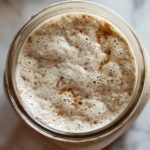Description
Learn how to create a lively and robust sourdough starter from scratch using just whole wheat and all-purpose flour combined with filtered water. This natural fermentation process cultivates wild yeast and beneficial bacteria, resulting in a flavorful, tangy starter perfect for baking delicious sourdough bread and other recipes.
Ingredients
Scale
Day 1
- 1 cup (120g) whole wheat flour
- 1/2 cup (120ml) filtered water
Feedings (Days 2–7)
- 1 cup (120g) unbleached all-purpose flour
- 1/2 cup (120ml) filtered water
- Additional flour and water as needed for daily feedings
Instructions
- Initial Mix: On Day 1, combine the whole wheat flour and filtered water in a large glass jar or a non-reactive container. Stir thoroughly until no dry flour remains, then cover loosely with a lid or cloth to allow airflow. Let it rest at room temperature (70–75°F) for 24 hours.
- First Feeding: On Day 2, check your starter; it may not show many changes yet. Discard about half (approximately 1/2 cup) of the starter. Feed it with 1 cup all-purpose flour and 1/2 cup filtered water, stir well, cover loosely, and let it rest at room temperature for another 24 hours.
- Daily Feedings: Repeat the discard and feeding routine daily from Day 3 through Day 7. Each day, remove half of the starter and replenish with 1 cup all-purpose flour and 1/2 cup water. Cover loosely and leave at room temperature.
- Observation of Activity: Around Day 4 or 5, look for bubbles forming on the surface and detect a pleasant tangy smell indicating yeast activity. If not visible, continue feedings as scheduled.
- Starter Maturity: By Day 6 or 7, your starter should double in volume within 4 to 6 hours after feeding and have a sour aroma. This indicates it’s ready to use in baking. If it hasn’t reached this stage, continue daily feedings until it does.
- Storage and Maintenance: Once mature, store your starter in the refrigerator and feed it weekly to maintain its activity. Before baking, feed the starter and allow it to become active by resting it at room temperature for 4 to 6 hours.
Notes
- Use filtered or dechlorinated water to avoid inhibiting wild yeast growth.
- You may switch entirely to all-purpose flour after Day 1 or blend with whole wheat or rye flour to develop different flavors.
- Keep your container loosely covered to allow airflow while preventing contamination.
- Consistent room temperature between 70–75°F optimizes yeast activity.

